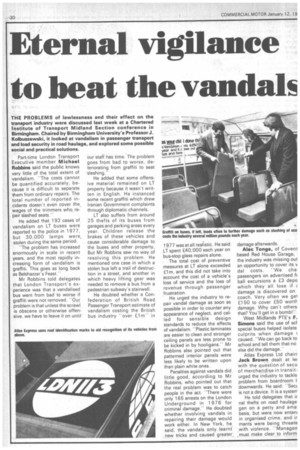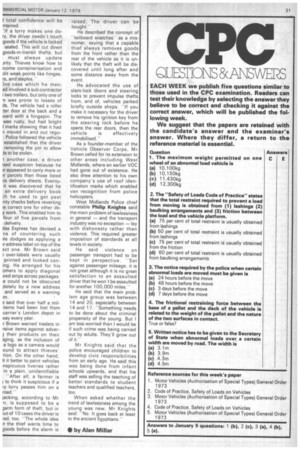Eternal vigilance to beat the vandals
Page 32

Page 33

If you've noticed an error in this article please click here to report it so we can fix it.
THE PROBLEMS of lawlessness and their effect on the transport industry were discussed last week at a Chartered Institute of Transport Midland Section conference in Birmingham. Chaired by Birmingham University's Professor J. Kolbuszewski, it looked at vandalism in passenger transport and load security in road haulage, and explored some possible social and practical solutions.
Part:time London Transport Executive member Michael Robbins said the public knows very little of the total extent of vandalism. "The costs cannot be quantified accurately, because it is difficult to separate them from ordinary repairs. The total number of reported incidents doesn't even cover the wages of the trimmers who. repair slashed seats."
He added that 193 cases of vandalism on LT buses were reported to the police in 1977, but 30,000 lamps were, stolen during the same period.
"The problem has increased enormously in scale in recent years, and the most rapidly increasing form of vandalism is graffiti. This goes as long back as Belshazzar's Feast."
Mr Robbins told delegates that London Transport's experience was that a vandalised bus went from bad to worse if graffiti were not removed. "Our problem is that unless the scrawl is obscene or otherwise offensive, we have to leave it on until our staff has time. The problem goes from bad to worse, deteriorating from graffiti to seat :slashing."
He added that some offensive material remained on LT property because it wasn't written in English. He instanced some recent graffiti which drew Iranian Government complaints through diplomatic channels.
LT also suffers from around 25 thefts of its buses from garages and parking areas every year. Children release the brakes of these vehicles and cause considerable damage to the buses and other property, But Mr Robbins saw no way of resolving this problem. He mentioned one case in which a stolen bus left a trail of destruction in a street, and another in which heavy lifting gear was needed to remove a bus from a pedestrian subway's stairwell.
He doubted whether a Confederation of British Road Passenger Transport estimate of vandalism costing the British bus industry "over £1m" in 1977 was at all realistic. He said LT spent £40,000 each year on bus-stop glass repairs alone.
The total cost of preventive measures at LT alone exceeded Elm, and this did not take into account the cost of a vehicle's loss of service and the loss of revenue through passenger frustration.
He urged the industry to repair vandal damage as soon as possible in order to counter any appearance of neglect, and called for sensible design standards to reduce the effects of vandalism. "Plastic laminates are easier to clean and stronger ceiling panels are less prone to be kicked in by hooligans." Mr Robbins also pointed out that patterned interior panels were less likely to be written upon than plain white ones.
Penalties against vandals did, little good, according to Mr Robbins, who pointed out that the real problem was to catch people in the act. "There were only 165 arrests on the London Underground in 1976 for criminal damage." He doubted whether involving vandals in repairing their damage would work either. In New York, he said, the vandals only learnt' new tricks and caused greater damage afterwards.
Alec Tonge, of Covent based Red House Garage, the industry was missing out an opportunity to cover its v dal costs. "We cha passengers on advertised ft ball excursions a £3 depo which they all lose if damage is discovered on coach. Very often we gel £150 to cover £50 worth damage. Why can't others that? You'll get in a bomb!"
West Midlands PTE's F. Simons said the use of scispecial buses helped isolate culprits when damage caused. "We can go back to school and tell them that no else did the damage.
Atlas Express Ltd chairr Jack Brown .dealt at ler with the question of secu of merchandise in transit. urged the industry to tackle problem from boardroom I downwards. He said: "Sect is not a device. It is a systerr He told delegates that ir nal thefts on road haulage gan on a petty and ama. basis, but were now entani in organised crime, and ir mants were being threate with violence. "Manager , must make clear to inform
t total confidence will be ntained.
'If a lorry makes one dery, the driver needn't touch goods if the vehicle is locked sealed. This will cut down goods-in-transit thefts, but must always update irity. Thieves know how to rcome containerisation and alit weak points like hinges, rs, and staples.'' )ne case which he mened involved a sub-contractor two trailers, but only one of ri was prone to losses of ds. The vehicle had a roller :ter door at the back and a Joard with a hingepin. The was rusty, but had bright I marks showing that it had moved in and out regu. Police followed the vehicle established that the driver removing the pin to allow is to be stolen.
-I another case, a driver
ised suspicion because he )r appeared to carry more or )r parcels than those listed us delivery sheets. Eventuit was discovered that he an extra delivery book :h he used to get past rity checks before reverting le correct one for other dey work. This enabled him to four of five parcels from delivery.
tlas Express has devised a ns of countering such )le dodges as applying a ir address label on top of the act one. Mr Brown said ) over-labels were usually printed and looked coning. He arranged for his Dmers to apply diagonal lred strips across packages. .e could not be obscured aletely by a new address and served as a warning ,m,
e said that over half a militems had been lost from carrier's London depot in rvay every year.
r Brown warned traders in nsive items against adver) their products on their aging, as the inclusion of a logo as a camera would ound to attract thieves' tion. On the other hand, It it better to paint vehicles ,nspicuous liveries rather in a plain, unidentifiable . "After all, a farmer is to think it suspicious if a cy lorry passes him on a road."
jacking, according to Mr .0, is supposed to be a garm form of theft, but in aut of 10 cases the driver is red, too. "The whole idea it the thief wants time to goods before the alarm is
raised. The driver can be bought."
He described the concept of "tailboard snatches" as a misnomer, saying that a capable thief always removes goods from the front rather than the rear of the vehicle as it is unlikely that the theft will be discovered until long after and some distance away from the event.
He advocated the use of slam-lock doors and steering locks to prevent impulse thefts from, and of, vehicles parked briefly outside shops. "If you make it necessary for the driver to remove his ignition key from the steering lock before he opens the rear doors, then the
vehicle is effectively immobilised.
As a founder-member of the Vehicle Observer Corps, Mr Brown called for its extension to, other areas including West Midlands, where an earlier VOC had gone out of existence. He also drew attention to his own company's use of roof identification marks which enabled van recognition from police helicopters.
West Midlands Police chief constable Philip Knights said the main problem of lawlessness in general — and the transport industry was no exception — lay with dishonesty rather than violence. This required greater imposition of standards at all levels in society.
He said violence on passenger transport had to be kept in perspective. -Set against passenger mileage, it is not great although it is no great satisfaction to an assaulted driver that he won't be assaulted for another 100,000 miles.
He said that the main problem age group was between 14 and 20, especially between 14 and 17. "Something needs to be done about the criminal propensity of the young. But I am less worried than I would be if such crime was being carried out by adults. They'll grow out of it."
Mr Knights said that the police encouraged children to develop civic responsibilities from an early age. He said this was being done from infant schools upwards, and that his staff was selling the teaching of better standards to student teachers and qualified teachers, too.
When asked whether the trend of lawlessness among the young was new, Mr Knights said: "No. It goes back at least to the ancient Egyptians.
• by Alan Millar
































































































































